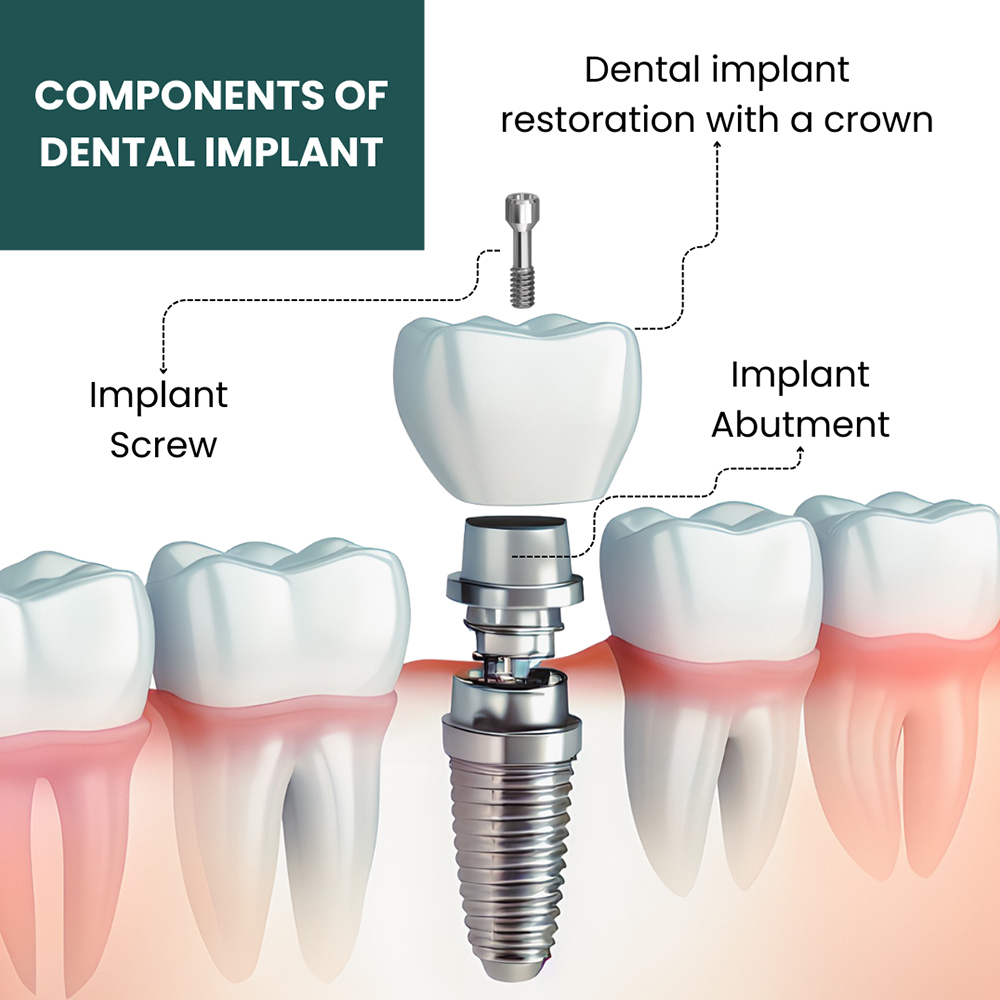What Does Dental Implants Do?
Table of ContentsGetting My Dental Implants To WorkThe 7-Second Trick For Dental ImplantsWhat Does Dental Implants Do?Dental Implants Things To Know Before You Buy
are clinical tools operatively dental implanted into the jaw to bring back a person's capability to eat or their appearance. They supply assistance for fabricated (phony) teeth, such as crowns, bridges, or dentures. When a tooth is shed because of injury or condition, an individual can experience difficulties such as rapid bone loss, faulty speech, or changes to chewing patterns that lead to pain.
Structure of The Oral Implant System choosing dental implants, speak with your oral copyright regarding the potential advantages and threats, and whether you are a candidate for the procedure. Points to think about: Your overall health is a vital aspect in determining whether you are a good prospect for dental implants, the length of time it will take to heal, and the length of time the implant might remain in location.
Smoking might influence the healing process and reduce the long-term success of the implant. The recovery procedure for the dental implant body might take several months or longer, during which time you generally have a temporary joint in area of the tooth. the oral implant treatment: Very carefully comply with the oral hygiene instructions offered to you by your oral provider.
Top Guidelines Of Dental Implants
Implant failing can lead to the need for another operation to take care of or replace the implant system. Brings back the ability to chew Recovers aesthetic look Helps keep the jawbone from reducing due to bone loss Protects the health and wellness of the bordering bone and gum tissues Assists maintain surrounding (neighboring) teeth steady Enhances lifestyle Damages to bordering natural teeth during implant positioning Injury to the surrounding cells throughout surgical treatment, such as sinus opening Injury during surgery (for example, fracture of surrounding jawbone) Poor function, such as really feeling like the teeth do not bite with each other normally A sensation that the tooth hangs or turning in position arising from a joint screw loosening Implant body failure (looseness of the implant body) as a result of systemic infection, which might be extra likely in patients with unrestrained diabetes mellitus due to local infection in bone and gum tissues supporting the implant body as a result of postponed recovery, which may be more probable in clients who smoke Difficulty cleaning up the gum tissues around the implant, resulting in poor oral health Untreated gum illness Post-surgical feeling numb as a result of nerve impingement or damage Constantly notify healthcare service providers and imaging service technicians that you have dental implants before any kind of magnetic linked here vibration imaging (MRI) or x-ray treatments.
FDA is not conscious of any type of damaging events reported for MRI or x-ray treatments with oral implants. Oral implants systems are usually made from products that comply with global consensus requirements of the International Organization for Standardization (ISO) or ASTM International. These requirements have information of what makes a risk-free product.
Various other materials such as gold alloys, cobalt-based alloys, titanium alloys, or ceramic products are often made use of. The safety accounts of these materials are widely known. Oral dental implant systems are evaluated according to global agreement standards. Biocompatibility screening, to show that bodily call with the tool does not cause complications like irritability or allergy, belongs to the examination that assists ensure the products in the dental implant system are secure and do not cause damaging impacts when dental implanted in people.

The Basic Principles Of Dental Implants
Some individuals are not qualified for oral implant surgical procedure. It is for oral surgeons to operate individuals with: severe illnessuncontrollable metabolic diseasebone or soft cells illness or infectionIf these problems are dealt with, a person can have the surgical treatment. Dental Implants. In, dental cosmetic surgeons avoid operating people with: If individuals with any one of the above go through dental implant surgical treatment, there is a higher risk of the dental implant falling short
Some individuals have a jawbone irregularity that protects against enough bone for an implant from developing. In such instances, a doctor might need to perform a ridge alteration. This involves lifting the gum tissue to subject the area of flawed bone. The doctor will certainly then use a bone or bone substitute to fix and construct up the location.
Oral implant surgical treatment is a tailored procedure. Give you time to heal. Affix the blog post and last crown, bridge or denture.
Next off, your doctor will very carefully position the oral implant right into your jaw. Ultimately, your cosmetic surgeon will rearrange your gum tissues and close the laceration with stitches. If your dental implant is near the front of your mouth, your dental professional will This Site certainly make a momentary tooth for you to use until you heal. That means, you won't have a space in your smile while you recoup.
How Dental Implants can Save You Time, Stress, and Money.
Your provider can tell you what to expect in your scenario. Throughout the healing stage, your jawbone ought to fuse to the dental implant. This process, called osseointegration, is vital for security and long-lasting success. This procedure can take anywhere from 3 to 9 months. In some instances, it may take longer.
When your dental implant heals, your dental expert can connect the abutment (little port blog post) and your final remediation (crown, bridge or denture). This normally takes about one hour to complete and may call for a 2nd small surgical treatment. You should not feel any type of pain during your dental implant treatment since hop over to these guys your service provider will utilize medicine to numb your gums.